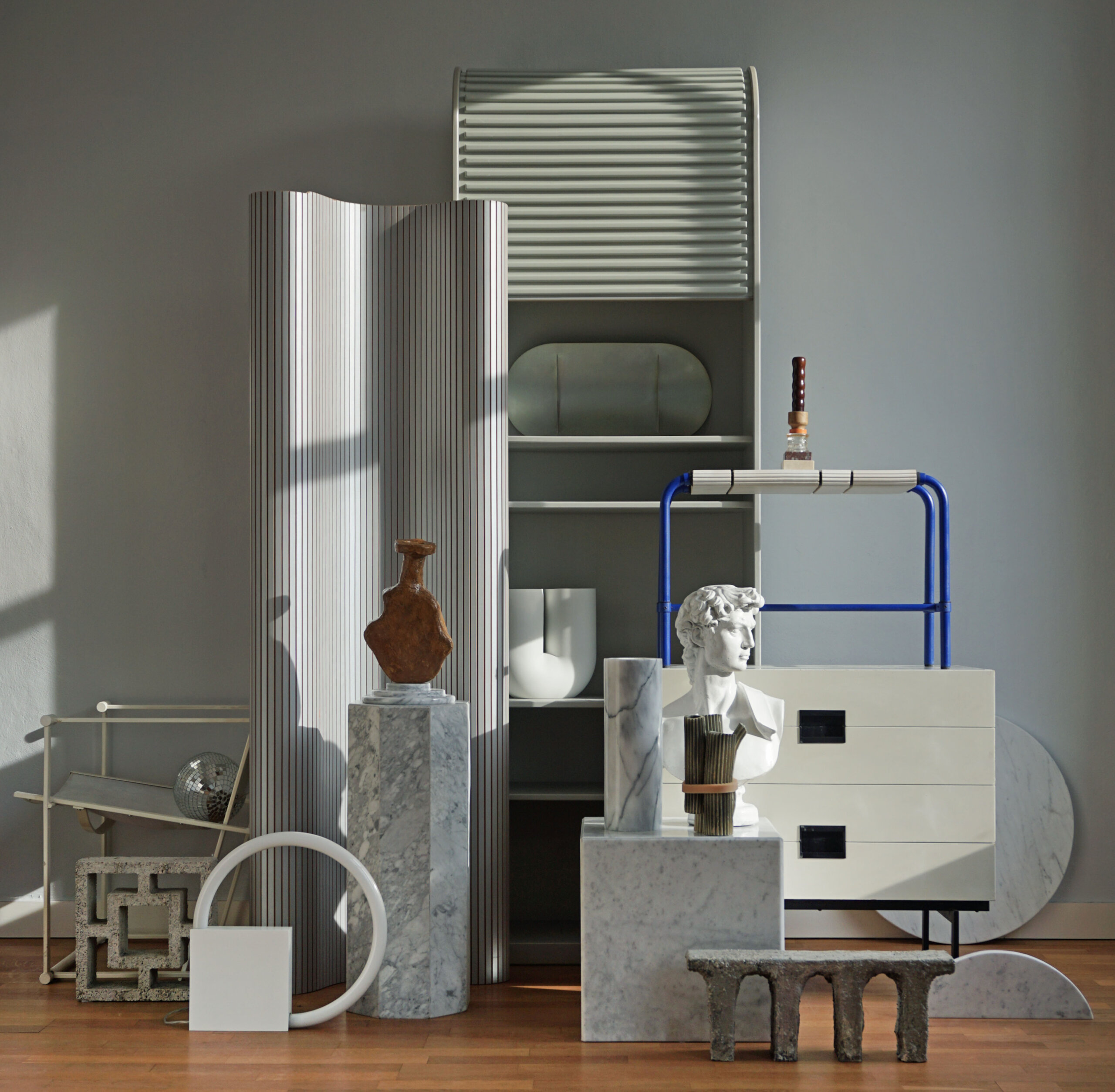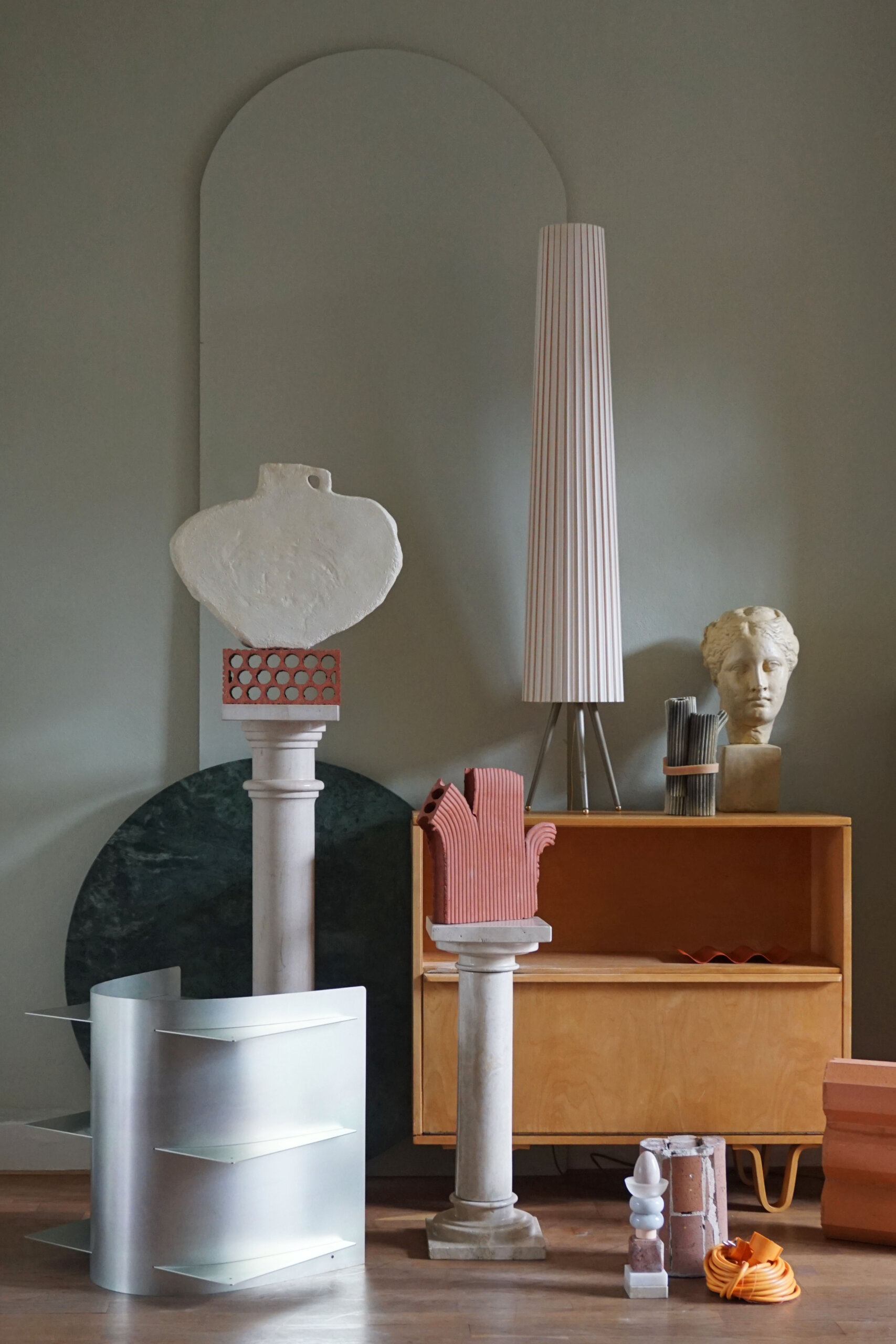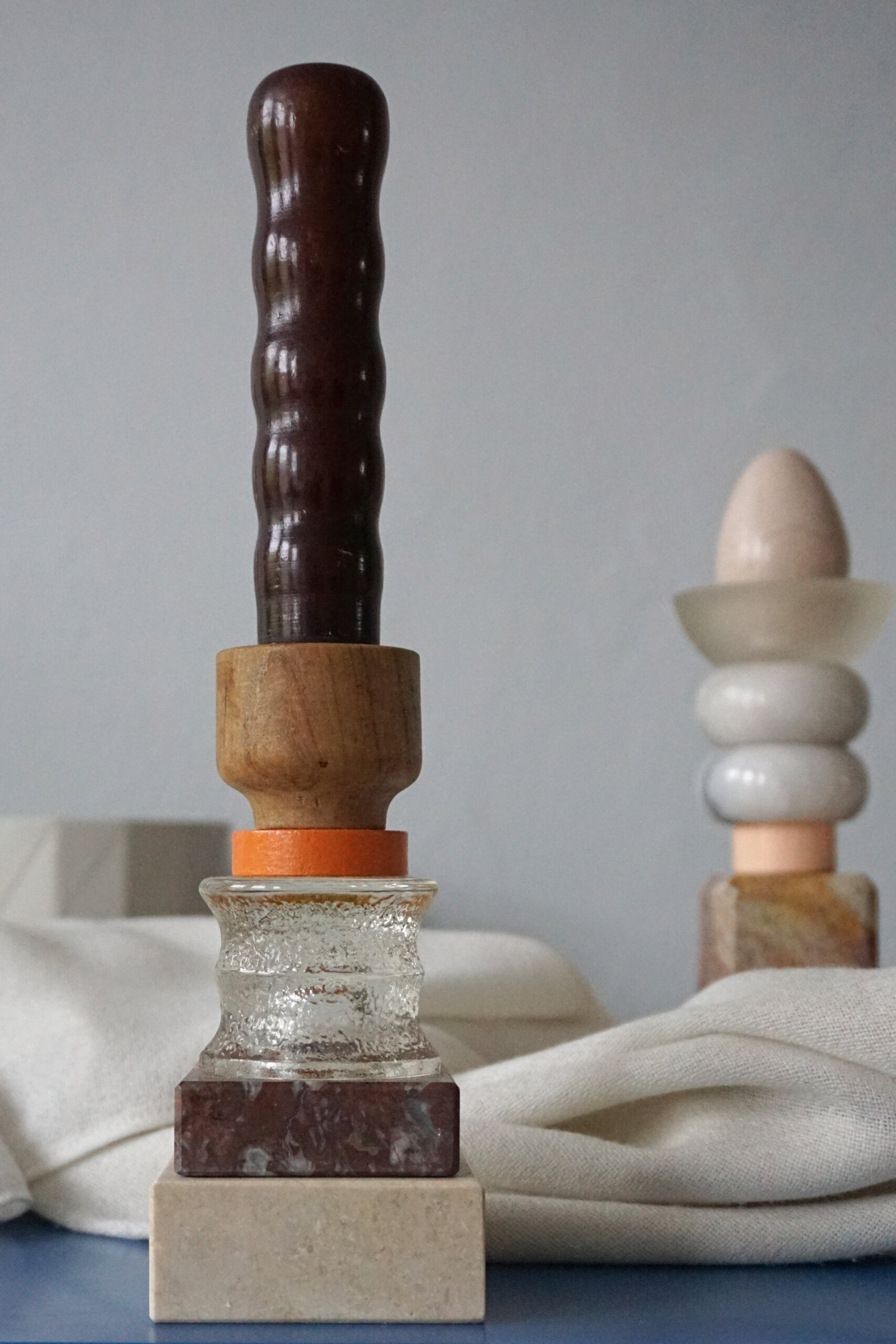

From left to right, vessel, Willem van Hooff, Tension bowl (placed in Pastoe cabinet), Paul Coenen, Balik bench (on top of white Pastoe cabinet) & Tumbula vase (on top of marble block), Studio Biskt. sculpture (on top of balik bench), Laura Schurink, arched bridge (on the floor), Willem van Hooff.
Isola goes digital
Title: Form follows fun
Written by: Berry Dijkstra
In light of current events, digital has replaced offline. So instead of walking through the streets of Milan on the lookout for design and exciting ideas, we plunge into a digital version of the Salone del Mobile. With this article, I share some of my favourite designers, their vision and their products. I will make clear why design is relevant in a world that is shaking on its foundations and how I keep creative as an interior stylist and design curator.
Since a while, I have been focusing on creating furniture compositions at home. By combining stunning products in such a way that they strengthen each other and on the other hand generating friction by putting items together that aren't quickly married. By taking away the functional aspect, the focus shifts to the composition, materials and colours. By placing a chair on a cabinet, the chair becomes a shape, a volume. By flipping and stacking and rearranging furniture in a nonfunctional way, I can free myself from the status quo, dogma's and rules and create a new narrative 'Form follows fun'.
When I was asked to write an article for Isola goes digital, it was clear that I would create new still lifes. The starting point is always my collection of vintage design mainly Pastoe classics, collectables, various pedestals and multiple everyday products. For this event, I selected five designers who caught my eye in recent days. The compositions are a humble tribute to a new generation of designers you have to keep your eye on.

Vessel, Core collection, Willem van Hooff
Willem van Hooff
Willem van Hooff graduated from the design academy in 2018. During my visit at Dutch Design week 2019, I came across his Core collection as part of the circle exhibition by Dutch invertuals.
Core is a series of flat vessels inspired by prehistoric African building techniques. Willem has been fascinated by vessels because they have such a clear and easy function; hold and transport water. It also was a canvas for humanity to express themselves. In ancient times, every tribe had their own specific shape in vessels. In research of expressing himself through new material, he found a challenge by developing a new form language. Because in Willems opinion, a lot of design is missing this freedom of expressing nowadays.
Willem calls the making naive and simple, "I think real ceramists will say it's not a proper technique", but the result keeps surprising him, and that is what he is looking for. By not claiming to be a master in ceramics is not hindered by rules or dogmas. This attitude, combined with a hunger for discovering new ideas, has led to the flat vessel collection. By transforming a vessel that has always been shaped round and three-dimensional into an extended version resulted in a new archetype. Every vessel is thinner than 10 cm and made out of two thick flat pieces of clay. The chamber that contains the water is placed in the middle of every vessel and gives them the balance they need. The vessels become even more stable when they are filled with water, and this offers Willem the freedom to create shapes surprisingly.

From left to right, Tension side table by Paul Coenen, vessel by Willem van Hooff,
Extruded clay experiment & Tulumba vase by Studio Biskt, sculpture (on the floor) by Laura Schurink
Paul Coenen
Paul Coenen graduated in 2019 from the Design Academy Eindhoven with his project Borders of Assembly. This collection was one of my personal highlights of the graduation show. Paul found out that many materials come into the market in a standardized size so that all machines can work with these materials. After producing the products, they are often made in a way that they fit precisely in a standard-sized box and those fit again on a standard size pallet and so on.
This standardization affects how everything in our surrounding is shaped. Paul started to look in these standard materials and techniques with the idea to find a way to use such material differently.
After experimenting with various materials and techniques, he ended up with standard-sized sheet metal. Sheet metal is often folded to create stiffness in the material, and to rule out, it's flexible characteristics. Instead of folding the steel, he used those flexible characteristics in his advantage. Bending the steel creates tension in the sheet, and this tension locks everything together. This results in a collection without any welds, screws or any other type of fasteners. The zinc-plated steel gives the objects a mesmerizing look, especially when they catch the light. Longevity, quality and timelessness are fundamental design aspects for Paul. He believes that a well-designed object stays at least a lifetime in circulation. Whether it's still with its first owner or sold on the second-hand market. This means that the purpose should not be affected by trends, so it will last over time and will keep its value.

Tension bowl (on top of pastoe cabinet & Tension side table (right), Paul Coenen
Studio Biskt
Charlotte and Martin both studied at ENSAV LA Chambre in Brussels. Charlotte got her degree in ceramics, and Martin graduated in industrial design. In 2018 they started to work together and founded Studio Biskt, a research-driven studio with a focus on extruding clay. Charlotte works and creates spontaneously, while Martin needs rules and restrictions to be creative. Two approaches which lead to hybrid products at the crossroads of art and design. Like the Balik collection.
I spotted the Balik bench during Collectible Fair in Brussels last March. The unusual combination of brutal modules, which reminded me of building bricks and a minimalistic shaped frame caught my attention. Balik was born from the idea of taking clay out its usual field as a building material. The duo started to extrude their own bricks (modules), which was not an easy job. Although the shape looks familiar to standard building bricks, they are not at all. It took Charlotte and Martin more than a year to give the modules the strength and aesthetic they were looking for. The Balik bench is the first step in further research of extruding bricks.
Tulumba is another extruded ambitious project by Charlotte and Martin. After a bunch of different experiments, they decided to focus on a churros shape. The outcome is a modular vase consisting of multiple cylinder-shaped tubes. The way and edges of the pipes make them interlock, and the volumes are held together with a silicone strap. The modular aspect results in a vase which can be composed in different ways.

Sculpture, Laura Schurink
Laura Schurink
After graduating in Fashion and Design at the Willem de Kooning in 2015, Laura realized she had no aspiration in becoming a fashion designer. It felt pointless to design and make clothes in a time where fast fashion has become the standard.
Determent to not support the fast fashion industry, she only shopped at second-hand stores. By visiting these stores, they became a source of inspiration. After a while, she began filling her studio with all the objects she found and started making still lives out of them. And from there it was a small step to deconstruct the objects and turn them into sculptures. By re-using objects and taking them out their original context to participate in new construction, she shows people the versatility of materials and discarded products.
The making process is a continues process. Laura takes the items apart, moves them around, turns them over and stacks them on top of each other. When a sculpture is not complete, she creates shapes out of different materials, adds colour, or she waits until she finds the right piece which is missing in the composition. By using recycling as a design tool, Laura can express her fascination for structures, materials, textures and colours, without having to compromise in her belief in the importance of sustainability.
We have five designers, with various backgrounds and a diverse range of materials and objects. When you take a closer look, you see the similarities in their design process. What they all have in common is questioning the status quo. This forms the basis for their research and experiments which lead to an answer, which will be shaped into a product, a new form of narrative. The pragmatic approach of Willem van Hooff resulted in redesigning an archetype. Paul Coenen found a way to assemble the furniture by letting the standardized materials work in his benefit. Charlotte and Martin focus on experimenting with clay, which resulted in a robust and fragile collection of objects. Laura Schurink shows us that recycling is fun and created a new form of language from discarded products.
It all starts with designers and artist who are raising questions and looking for solutions. These outcomes, experiments and products are a first step in creating awareness and often lead to changes on a larger scale. A message which gives me high hopes for the future of design. Now that we are in the middle of a global pandemic, it is time for reflection and evaluating our behaviour. To raise questions about the production chains, the products we buy, the circulation speed of trends and the quality of products. My advice, buy less choose well. Start buying with your heart, go for vintage items, make choices, develop your own taste and style based on what you love instead of trends. Details are not details they make the design. Support designers by buying and sharing their work. In the end, it's all about surrounding yourself with items and objects that make you happy, tell a story and therefore they will stay with you for a very long time.